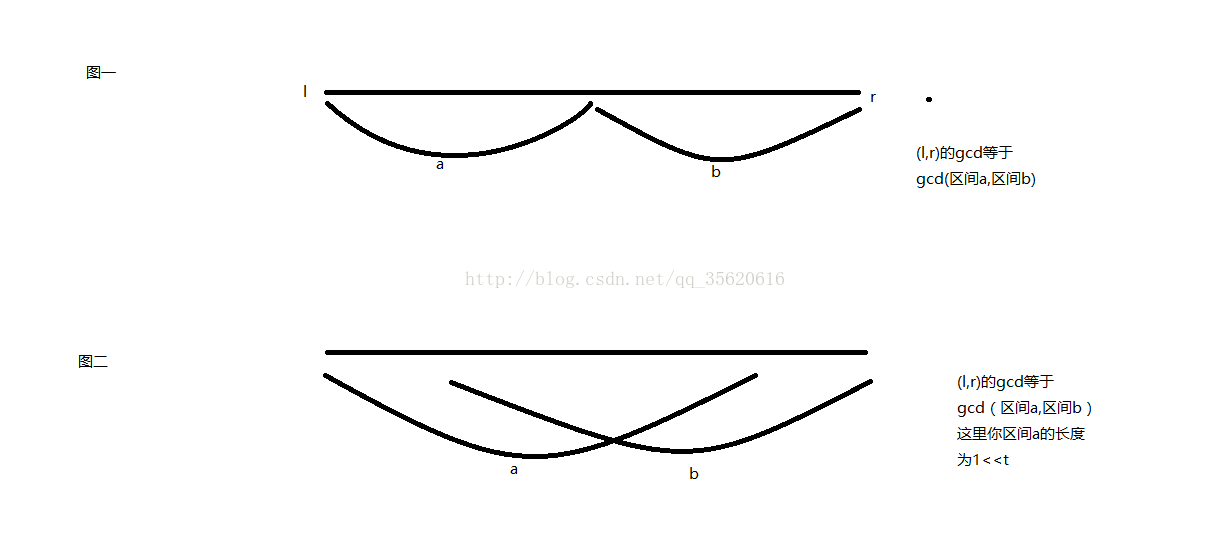hdu 5726 GCD 解题报告
Give you a sequence of
N(N≤100,000) integers :
a1,...,an(0<ai≤1000,000,000). There are
Q(Q≤100,000) queries. For each query
l,r you have to calculate
gcd(al,,al+1,...,ar) and count the number of pairs
(l′,r′)(1≤l<r≤N)such that
gcd(al′,al′+1,...,ar′) equal
gcd(al,al+1,...,ar)
The first line of each case contains a number N, denoting the number of integers.
The second line contains N integers, a1,...,an(0<ai≤1000,000,000).
The third line contains a number Q, denoting the number of queries.
For the next Q lines, i-th line contains two number , stand for the li,ri, stand for the i-th queries.
Output For each case, you need to output “Case #:t” at the beginning.(with quotes, t means the number of the test case, begin from 1).
For each query, you need to output the two numbers in a line. The first number stands for gcd(al,al+1,...,ar) and the second number stands for the number of pairs (l′,r′) such that gcd(al′,al′+1,...,ar′) equal gcd(al,al+1,...,ar).
Sample Input
The first line of each case contains a number N, denoting the number of integers.
The second line contains N integers, a1,...,an(0<ai≤1000,000,000).
The third line contains a number Q, denoting the number of queries.
For the next Q lines, i-th line contains two number , stand for the li,ri, stand for the i-th queries.
Output For each case, you need to output “Case #:t” at the beginning.(with quotes, t means the number of the test case, begin from 1).
For each query, you need to output the two numbers in a line. The first number stands for gcd(al,al+1,...,ar) and the second number stands for the number of pairs (l′,r′) such that gcd(al′,al′+1,...,ar′) equal gcd(al,al+1,...,ar).
Sample Input 题意:

.
Input The first line of input contains a number
T, which stands for the number of test cases you need to solve.
The first line of each case contains a number N, denoting the number of integers.
The second line contains N integers, a1,...,an(0<ai≤1000,000,000).
The third line contains a number Q, denoting the number of queries.
For the next Q lines, i-th line contains two number , stand for the li,ri, stand for the i-th queries.
Output For each case, you need to output “Case #:t” at the beginning.(with quotes, t means the number of the test case, begin from 1).
For each query, you need to output the two numbers in a line. The first number stands for gcd(al,al+1,...,ar) and the second number stands for the number of pairs (l′,r′) such that gcd(al′,al′+1,...,ar′) equal gcd(al,al+1,...,ar).
Sample Input
1 5 1 2 4 6 7 4 1 5 2 4 3 4 4 4Sample Output
Give you a sequence of N(N≤100,000) integers : a1,...,an(0<ai≤1000,000,000). There are Q(Q≤100,000) queries. For each query l,r you have to calculate gcd(al,,al+1,...,ar) and count the number of pairs(l′,r′)(1≤l<r≤N)such that gcd(al′,al′+1,...,ar′) equal gcd(al,al+1,...,ar)
.
Input The first line of input contains a number
T, which stands for the number of test cases you need to solve.
The first line of each case contains a number N, denoting the number of integers.
The second line contains N integers, a1,...,an(0<ai≤1000,000,000).
The third line contains a number Q, denoting the number of queries.
For the next Q lines, i-th line contains two number , stand for the li,ri, stand for the i-th queries.
Output For each case, you need to output “Case #:t” at the beginning.(with quotes, t means the number of the test case, begin from 1).
For each query, you need to output the two numbers in a line. The first number stands for gcd(al,al+1,...,ar) and the second number stands for the number of pairs (l′,r′) such that gcd(al′,al′+1,...,ar′) equal gcd(al,al+1,...,ar).
Sample Input
1 5 1 2 4 6 7 4 1 5 2 4 3 4 4 4Sample Output
Case #1: 1 8 2 4 2 4 6 1
给你n个数字,现在问你q次L,R区间的gcd值以及有多少个区间的gcd值和L,R相等(L,R本身也算一个)
思路:
先用rmq预处理计算任意区间的gcd值;然后计算和该区间gcd相等的区间有多少个,代码如下:
#include //建议从主函数开始看
using namespace std;
#define LL long long
const int maxn = 100005;
int dp[maxn][20];//dp[i][j]代表从第i位开始往后(1<m;//m[i]代表gcd值为i的区间有多少个
int main(){
int test;
scanf("%d",&test);
int T=0;
while(test--){
T++;
m.clear();
scanf("%d",&n);
for(int i=1;i<=n;i++)scanf("%d",&num[i]);
init();
for(int i=1;i<=n;i++){//这里统计各区间的gcd值
int l=i,r=i;//当你计算l,r的区间gcd值时随着r的增加这个值一定是递减的,所以我们可以这样计算:
//首先枚举i端点,然后二分找到一个最右边的r使区间(l,r)的gcd等于(l,l),也就是说此时(l,r+1)是一个比之前小的gcd值,再如法炮制从(l,r+1)找有多少个和(l,r+1)
//gcd值相等的区间,由于不知道什么鬼的证明说对于一个端点i最多能找出来log2(n)个gcd值,而每次找的复杂度为log2(n),所以这里整体复杂度为n*logn*logn;
while(r<=n){
int ll=r;
int rr=n;
int v=rmq(l,r);
while(ll<=rr){//二分找有多少个区间gcd等于(l,r)
int mid=(rr+ll)/2;
if(rmq(l,mid)>=v)ll=mid+1;
else rr=mid-1;
}
m[v]+=ll-r;
r=ll;//更新r,这样可以继续找
}
}
int q;
scanf("%d",&q);
printf("Case #%d:\n",T);
while(q--){
int L,R;
scanf("%d%d",&L,&R);
int ans=rmq(L,R);
printf("%d %lld\n",ans,m[ans]);
}
}
}
